|
Cooking was often done outdoors in a fulacht fia and many of these date from the Bronze Age. A pit lined with wooden planks was filled with water which was brought to the boil by adding stones heated in a fire nearby. Meat, wrapped in straw, was cooked in the water which was kept simmering by the addition of more hot stones when required. The straw kept the meat clean and allowed it to float so it was more easily recovered from the hot water and stones. |
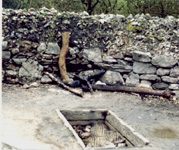 Fulacht fia - modern reconstruction Courtesy Irish National Heritage Park, Ferrycarrig, Wexford |
Archaeologists believe that élite groups existed during the Bronze Age and displayed their status with impressive artefacts. Very fine personal ornaments were made from native gold, while jet and amber were imported - the latter from the Baltic.
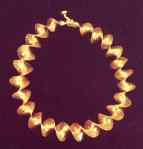
Bronze Age torc c. 1200 BC |
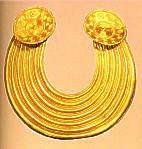
Glininsheen Gorget |
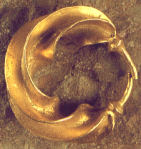
Bronze Age earring c. 1200 BC |

Later Bronze Age gold objects |
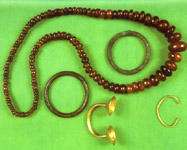
Later Bronze Age gold, amber |
But the majority of the population still depended on farming to survive and several factors combined to make life difficult for them in the later Bronze Age.
- Evidence from pollen counts and tree rings shows that long periods of cold, wet climate led to poor returns from crops.
- Pollen counts show abuse of soils due to 2,000 years of farming.
- Clearance of woodlands for farming and for smelting copper caused the growth of blanket bog on higher ground.
- Areas of lowlands were flooded.
- Increasing population must have led to competition for the remaining resources and the need to protect the possessions of the group from theft.
- The consequence of the above factors meant pressure on remaining farm land.
| Basing her conclusions on a survey of 186 cultures, the anthropologist Peggy Reeves Sanday hypothesises that in the earliest human societies, before population pressure, women and men may have lived in a relatively egalitarian fashion. But as their numbers grew, and hunger, forced migration, or war against other groups became the means for the group's survival, the tendency to subordinate women became more likely. In such societies, female subordination was rationalised and justified … Males were supposed to be active and aggressive, females passive and obedient. Bonnie S. Anderson & J.P. Zinsser, A history of their own, Penguin Books, 1988, p. 14. |
|
Was warrior culture widespread? Did women and children have lower status? Did women accept an inferior status in return for protection as warrior males fought each other? The Greek epics of Homer and parts of the Old Testament dating from about the same time portray warrior cultures in which the lower status of women is taken for granted. A historical or literary picture of Bronze Age society in Ireland is not available because we have no written records for the period. |

Bronze Age spearheads |
Questions
- Bronze is a mixture of _____ and _____.
- Briefly describe a fulacht fia.
- Identify two pieces of evidence in the above section for the existence of travel or trade between Ireland and abroad.
- How do archaeologists know that the climate and environment would have made life difficult for the people of the Later Bronze Age in Ireland?
- Do you think it likely that women were subordinated in Ireland in the Later Bronze Age? Give reasons for your opinion.
- Why do you think Bronze Age people placed razors and military objects in the graves of their men?
Activities
- Write an essay on the role of women in warrior cultures.
- Design a menu for a fulacht fia meal out of doors and compose one recipe.
- Invite a teacher of metalwork to discuss the production and use of copper, bronze and gold.
- Invite an archaeologist to discuss the Bronze Age.
- Visit Bronze Age monuments in your area.
- Do a project on Ireland's Bronze Age treasures.
- Select a small number of stories from Homer and/or the Old Testament which, in your opinion, reveal any aspect of their society's attitude to women.